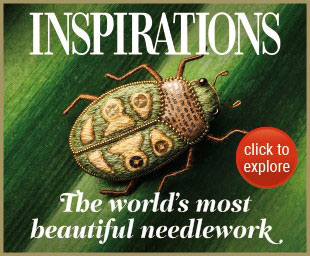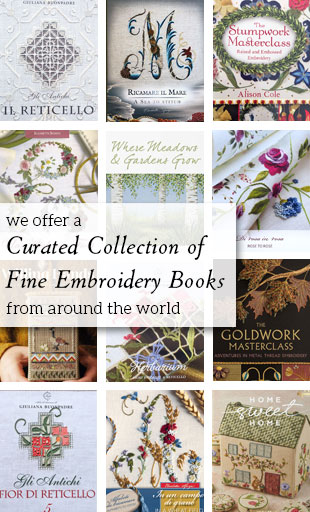In case you have time to meander through the online embroidery and needlework world this weekend, I thought I’d point out a few spots that might be fun or interesting to visit.
If you’re looking for – or like to collect – needlework books, you might try the Mad Samplar Book Company. They specialize in used and new needlework books. There are a couple gems on there worth noting. If you are looking for something specific that isn’t listed, you can always let them know what you want to see if they can find it. I love used book services! (Thanks for the link, Megan!)
If you want to see an interesting combination of canvas work (needlepoint) and surface embroidery, check out Judy’s January TIF Challenge post. Imitating the look of crazy quilting, she’s made her “fabric” out of canvas stitches, and is treating the “seams” between the different canvas stitches with surface embroidery. Clever idea, and really very pretty and elegant.
My latest forays into casual embroidery have been in the area of canvas stitches. Strangely enough, I’ve never ever ever liked needlepoint, until now. I don’t know what has suddenly attracted me, but, generally, it’s “historical” needlework that catches my eye, and I think this is what happened in this case. In short, I believe it was the concept of the “slip” that first snagged me – the popular 16th / 17th century decoration worked on linen in tent stitch, then cut out and fixed to a background fabric. In fact, I mentioned before this needlepoint canvas that is based on historical slips from the Traquair House in Scotland. I think that’s what caught my interest in the first place.
So I’ve been exploring canvas stitches, and I wanted to mention a few (perhaps obvious) points about them: 1. They don’t have to be worked on needlepoint canvas. They can be worked on even weave linen just as easily; 2. I think it’s easier to work them (especially if you’re working on a softer cloth, rather than a stiff canvas) in a frame or hoop; 3. You should have a proclivity towards squares.
Anyway, if you’re interested in giving your embroidery a different look and want to check out some canvas stitches, there are plenty of places online that can help you. Keep in mind that some of these stitches can be worked in isolation, so they aren’t necessarily just for canvas or even weave fabric.
First of all, there’s the Needlepoint Now online classroom. This is a handy place to learn about the three different types of tent stitch. You can find a nice tutorial on the same thing at Threadneedle Street.
If you want to get a look at a variety of canvas stitches in different applications, you should check out the American Needlepoint Guild’s stitch of the month index. You’ll find variations on all kinds of different canvas stitches.
For interesting articles on historical slips, you might check out Jane Stockton’s page, In Prayse of the Needle, where, if you scroll down, you’ll find a PDF on Elizabethan slips.
Now, in case you think I’ve gone off my surface embroidery rocker – don’t worry! My upcoming serious projects (they’re stuck still in the designing stage, but will be progressing into the working stage soon!) are all surface embroidery, including several liturgical projects on the plate for this year.
And – joy, bliss – next week, the garage begins undergoing reconstruction, so I should have a normal workroom space within a few weeks! And that means I can actually make better progress on serious stuff.
The demands of my job are keeping me exceptionally busy right now, but by the middle of this coming week, I should have some breathing room – then I’ll entertain you with some photos! In the meantime, though, I plan to post a couple new video tutorials.
Enjoy the weekend with your needle ‘n thread!







thanks for this great info. Also thanks for running the competetion (which I won!) I tried several times to leave a comment, but blogger was being uncooperative again! anyway thanks!
I never found needlepoint very appealing, but I’m hooked on slips now–they combine my love of botanical illustration with nice, relatively forgiving embroidery. In lots of colors! I adore that Traquair House one you have.
Plus I like my embroidery to be both historical and useful, and bookcovers and cushions and sweet bags are all very useful projects, well suited to needlepoint techniques.
Mary,
I found your site very interesting and useful. I am trying to start some embroidery on a royal blue saree. Can I know what all colors would go well with this color?
Thanks
Wow – sounds like a big project!! How about gold and white? I guess it depends on how colorful you want to get! On royal blue you could always go with jewel tones – deep red, deep green, deep gold… anyone else have any ideas?
Depending on the pattern if you could use just one color, how about variegated blue.
Hello Mary – I sometimes send comments but don’t see them posted. Is it because you want to keep up variety of responses or because you don’t receive them? I will try sending this message several ways just in case.
From Laura Bullinger
Hi, Laura!
Well, this one came through! Glad to see you again.
You can always use the contact information in the top menu, if you want.
I still haven’t finished repairing that cloth of gold stole! It’s on my list for this year, though!
For royal blue saree I suggest using color trio : copper (in metallic) with touch of deep forest green and large areas of creamy banana. This is a sophisticated grouping.
For a more Midnight look use accents of deep purple and black (shiny jet or real beads) in equal amounts to the royal blue. This may look if